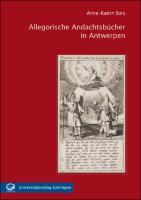Allegorische Andachtsbücher in Antwerpen
Jan Davids Texte und Theodoor Galles Illustrationen in den jesuitischen Buchprojekten der Plantiniana
Author(s)
Sors, Anne-Katrin,
Collection
AG UniversitätsverlageLanguage
GermanAbstract
Die bei Plantin-Moretus um 1600 in Antwerpen gedruckten, von Jan David SJ verfassten und durch Theodoor Galle aufwendig illustrierten Andachtsbücher werden erstmals vollständig und systematisch, unter Berücksichtigung der Texte und zugehöriger Bilder, vorgestellt und untersucht. Deren komplexe Kupfersticherfindungen sind nicht – wie bislang angenommen – Emblemvarianten, sondern stellen ein gänzlich anders funktionierendes System der Text- und Bild-Synthese dar. Der jeweiligen Andachts-, Erbauungs- oder Lehrfunktion entsprechend verbildlichen die Kupferstiche Allegorisierungen moralischer und religiöser Didaxe, bildinterne Lettern und beigefügte Erläuterungen erschließen Inhalte und stellen den Bezug zu den verbildlichten Texten her. Analyse der unterschiedlichen Text-Bild-Verschränkungen in den vier Büchern, Herleitung der Buchstabenverweissysteme, buchgeschichtliche Einordnung, Entstehungsumstände, Konzeptionsgeschichte, funktionale Bestimmungen und Rezeptionen der Bücher und Bilder werden umfassend geklärt. Neben Veridicus Christianus (1601), Occasio Arrepta Neglecta (1605), Paradisus Sponsi et Sponsae (1607) und Duodecim Specula (1610) wurde auch das umfangreiche und viel rezipierte, von Boetius a Bolswert illustrierte Via Vitae Aeternae (1620) des Antoine Sucquet SJ ausführlich behandelt. The devotional books printed by Plantin-Moretus in Antwerp around 1600, written by Jan David SJ and lavishly illustrated by Theodoor Galle, are presented and examined for the first time completely and systematically, taking into account the texts and associated images. Their complex copperplate engravings are not - as previously assumed - emblem variants, but represent a completely different system of text and image synthesis. According to the respective devotional, edifying, or teaching function, the copperplate engravings illustrate allegorizations of moral and religious didacticism; letters within the image and attached explanations make the contents accessible and establish the reference to the illustrated texts. Analysis of the different text-image interweavings in the four books, derivation of the letter reference systems, book-historical classification, circumstances of origin, history of conception, functional determinations and receptions of the books and images are comprehensively clarified. In addition to Veridicus Christianus (1601), Occasio Arrepta Neglecta (1605), Paradisus Sponsi et Sponsae (1607), and Duodecim Specula (1610), the extensive and much-received Via Vitae Aeternae (1620) by Antoine Sucquet SJ, illustrated by Boetius a Bolswert, was also treated in detail.
Translated with www.DeepL.com/Translator (free version)
URI
http://library.oapen.org/handle/20.500.12657/32462https://library.oapen.org/handle/20.500.12657/47573
Keywords
devotional books; Catholicism; allegory; Antwerpen; Emblem (Kunstform); Galle; Jesuiten; KupferstichDOI
10.17875/gup2015-841ISBN
9783863952341OCN
1097094143Publisher
Universitätsverlag GöttingenPublication date and place
2015Classification
The arts


 Download
Download Web Shop
Web Shop